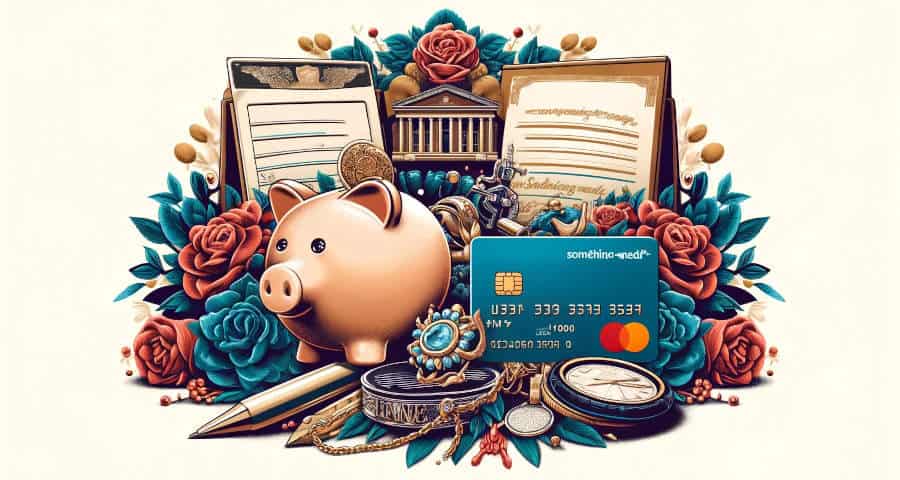Every couple dreams of their perfect wedding day, filled with love, laughter, and cherished memories.
It would indeed be wonderful to plan such a day without any financial constraints, allowing you to focus purely on creating an event that perfectly reflects your vision and desires.
However, balancing the vision for your wedding with practical financial considerations is crucial.
This balance is important not only for the day itself but also for the health of your relationship and your future together.
Having a budget and sticking to it doesn’t mean your wedding will be any less wonderful.
In fact, it can lead to a very special and memorable day that’s creatively tailored to reflect what truly matters to you and your partner, making it all the more meaningful.
Set a Realistic Budget

Before you can effectively plan a wedding on a budget, you first need to establish what that budget is.
Setting a realistic budget is a crucial initial step because it lays the groundwork for all subsequent decisions in the planning process.
A realistic budget is one that takes into account the couple’s available funds, any potential contributions from family members, and the overall vision for the wedding.
It ensures that the financial planning aligns with what is practically achievable, preventing financial strain and ensuring that you can enjoy your special day without worrying about going over budget.
Here are a few quick tips on how to set a realistic budget:
- Discuss Finances Openly: Sit down with your partner and discuss your financial situation in detail. This includes your savings, income, and any debts that might affect your budgeting.
- List Your Priorities: Determine what aspects of the wedding are most important to both of you. Whether it’s the venue, photography, or food, knowing your priorities helps focus your budget on what truly matters.
- Allocate Funds Accordingly: Divide your total budget based on your priorities. Allocate a higher percentage of your budget to high-priority items and look for cost-saving alternatives for lower-priority areas.
This kind of budget acts as a foundation for every decision, influencing the scale of the wedding, choice of vendors, the venue, the number of guests, and even the style of the wedding. Without a clear and realistic budget, it’s easy to make choices that might not be financially sustainable.
For detailed insights into creating your wedding budget, including practical examples and how to incorporate your vision and dreams into your financial limits, read my comprehensive guide: Setting Your Wedding Budget.
While setting a realistic budget is vital, it’s equally crucial to understand typical wedding expenses. This knowledge allows you to make informed decisions and avoid common financial pitfalls. For a detailed breakdown of potential costs I have a guide on Understanding Typical Wedding Expenses.
Building Your Wedding Fund

Planning a wedding is an exciting time, but it can also bring financial stress. Establishing a dedicated wedding fund is crucial for managing expenses without compromising the joy of your special day.
A well organised wedding fund not only helps keep your finances on track but also reduces anxiety, allowing you and your partner to focus on what truly matters, celebrating your love.
Once you have a budget set for your wedding, the next important step is to assess your current financial position. Start by evaluating how much money you already have that can be allocated towards the wedding.
This might include general savings, a specific wedding fund you’ve started, or other assets you’re prepared to use.
Discuss potential financial contributions with family members or friends who may be willing to help. It’s crucial to have these conversations early to secure a clear commitment on the amount they are willing to contribute, avoiding any misunderstandings or changes in financial support later on.
For more detailed insights into external contributions, be sure to read our in-depth article, “Who Actually Pays for the Wedding?”.
Next, subtract the total amount of your current savings and confirmed contributions from your overall wedding budget to determine how much more you need to save.
For example, if your total wedding budget is $20,000 and you have $5,000 in savings plus $5,000 from family contributions, you would still need to save an additional $10,000.
Divide this remaining amount by the number of months until your wedding to establish your monthly savings target. Continuing with the previous example, if you need to save $10,000 and you have 10 months until your wedding, your monthly savings target would be $1,000.
Utilise financial tools and apps to help manage this process. These tools can provide a visual representation of your savings progress and help keep you motivated. They can also alert you if you are falling behind, giving you time to adjust your spending habits accordingly.
Make it a habit to review your savings progress and budget monthly. This regular check-in not only helps ensure you are on track but also allows you to make adjustments if unexpected expenses arise or if you find opportunities to save more than anticipated. This careful monitoring and adjustment of your wedding fund will help you achieve your financial goals without undue stress, allowing you to enjoy the journey to your big day.
Other Funding Options

Despite your best efforts to save, you may find that the gap between your target budget and the amount you can realistically save before your wedding is too wide. In such cases, exploring other funding options may be necessary to make your dream wedding a reality.
Consider a Longer Engagement: Extending your engagement can provide additional time to save for your wedding. This not only allows you to accumulate more savings but also gives you more flexibility to book venues and vendors during less expensive times of the year, significantly reducing costs and better aligning with your budget.
Personal Loans: Taking out a wedding loan or personal loan can be a viable option if you’re confident in your ability to repay it within a reasonable timeframe. Shop around for loans with the best rates and terms, and be sure to carefully consider the repayment conditions before committing. Remember that taking on debt always carries some risk, so it’s essential to have a clear plan for repayment.
Credit Cards: Using credit cards can offer a temporary solution for immediate expenses, especially if you can take advantage of low-interest offers or rewards programs. However, it’s crucial to manage this carefully to avoid accumulating high-interest debt. Make sure to use credit cards responsibly and have a plan to pay off any balances quickly.
Seek Help Instead of Gifts: In modern weddings, it’s becoming increasingly common for couples to ask for financial help instead of traditional wedding gifts. This approach is particularly useful for those who already have established homes and do not need the typical household items that are often given as gifts. Various websites and services facilitate this by allowing guests to contribute directly to your wedding fund or honeymoon expenses. This option is convenient for both the couple and their guests, streamlining the process and ensuring that contributions are both meaningful and practical.
The primary reason to build a wedding fund or consider a longer engagement is to avoid starting your married life in debt. Weddings can be expensive, and resorting to loans or credit cards can lead to high interest charges and financial stress.
This can start your married life on a challenging note. By carefully planning your finances and communicating openly with your partner, you can establish a strong financial foundation for your marriage while still having the wedding of your dreams
Think Outside the Box

When planning a wedding on a budget, thinking creatively and considering non traditional options can lead to significant savings without compromising the overall experience.
Here are a few ideas to inspire your budget-friendly wedding planning:
Alternative Venues: Consider unconventional venues that align with your style and budget. Options like parks, beaches, libraries, or even a family member’s backyard can provide a beautiful setting at a fraction of the cost of traditional wedding venues. These spaces often allow for more flexibility in terms of catering and decorations, giving you more control over expenses.
DIY Elements: Embrace your creativity and take on some DIY projects to personalise your wedding while saving money. From crafting your own invitations and decorations to arranging your own floral centrepieces, there are countless opportunities to add a personal touch without breaking the bank. Enlist the help of friends and family who have specific skills or talents to make the process even more enjoyable and cost-effective.
Off-Peak Timing: Choosing an off-peak wedding date can result in substantial savings. Consider a Friday evening or Sunday afternoon wedding, or opt for a less popular month like January or February. Venues and vendors often offer reduced rates for these less sought-after times, allowing you to secure your dream team at a more affordable price point.
Simplify the Menu: Instead of a multi-course plated dinner, consider a buffet-style meal or even a cocktail reception with heavy hors d’oeuvres. These options can be just as satisfying for your guests while being more budget-friendly. You can also opt for a smaller wedding cake and supplement with a dessert bar featuring homemade treats or local specialties.
Alternative Wedding Attire: Wedding attire can be a significant expense, but there are several ways to save money without sacrificing style or quality. Consider renting dresses or suits as a cost-effective alternative to purchasing, buying off-the-rack dresses or suits and having them tailored to fit, or exploring second-hand or vintage dresses. For bridesmaids, consider providing a color palette and allowing them to choose their own styles to help them stay within their individual budgets and feel comfortable and confident.
Remember, your wedding attire should make you feel beautiful and confident, but it doesn’t have to break the bank. By exploring alternative options and being open to non-traditional choices, you can find the perfect ensemble that fits both your style and your budget.
Prioritise Photography: While it may be tempting to cut costs on photography, remember that these images will be your lasting memories of the day. Consider prioritising a skilled photographer and opting for a smaller package or reducing hours of coverage to fit your budget. You can always expand your album or order prints later when finances allow.
Limit the Guest List: One of the most effective ways to reduce overall wedding costs is to limit the number of guests. Focus on inviting those who are truly closest to you and your partner. A smaller, more intimate celebration not only saves money but also allows for more meaningful interactions and memories with your loved ones.
Remember, a budget-friendly wedding is not about cutting corners or settling for less. It’s about being resourceful, creative, and focusing on what truly matters, celebrating your love story with those nearest and dearest to you. By thinking outside the box and embracing non-traditional options, you can create a unique and memorable wedding day that perfectly reflects your personalities and values.
At the end of the day, your wedding is a celebration of the love between you and your partner. While it’s easy to get caught up in the details and the desire for a picture perfect day, remember that the most important thing is the commitment you’re making to each other. By focusing on your love story and creating a day that authentically represents your relationship, you’ll create cherished memories that will last a lifetime regardless of your budget.

